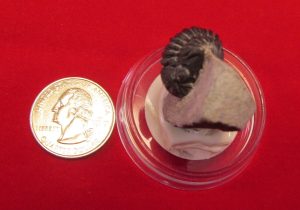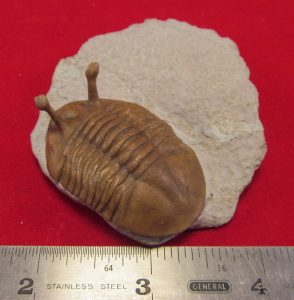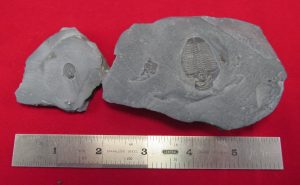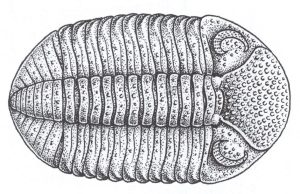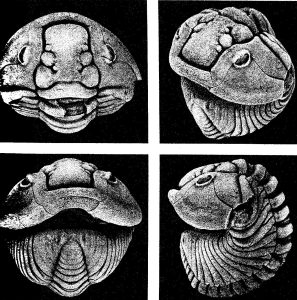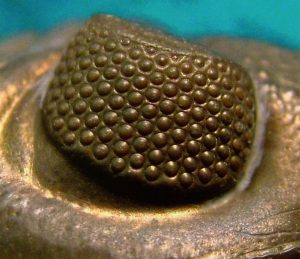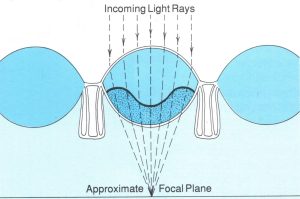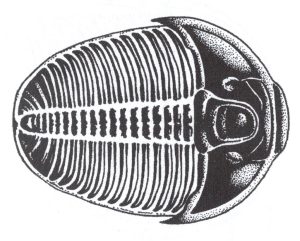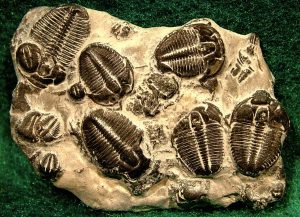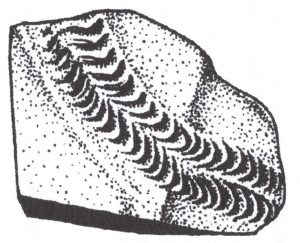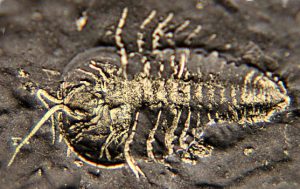Trilobites have three parallel sections or lobes that make up their bodies and thus the name tri-lobe-ite. Their name should not be mispronounced trill-o-bite. These arthropods are found in the rock record by the billions in sedimentary rock all over the earth. They have many variations, and many species, genera, and family names have been assigned to them mostly by evolutionists. According to various authorities the number of species names is somewhere between 3,900 and 25,000, the number of genera is somewhere between 1,500 and 5,000, and the number of families is somewhere between 56 and 200. I have written previously about the great amount of disagreement among paleontologists regarding the scientific naming of fossil life forms. What I have found regarding this is that one generation of “splitters” accumulates a bunch of fossil names as a result of the scientists’ drive for self-recognition, and the next generation of “lumpers” decreases the number of lifeform names into a much smaller number after closer examination of the remains. I have seen this especially in my examinations of the scientific naming of dinosaurs and fossil mammals.
I have not done a similar examination for the naming of trilobites, but my guess is that there were probably less than 200 created kinds of trilobites in the beginning. Creationists often ascribe the created kind category to the family or close to the family. Most of the fossils of all kinds that have been found are the result of the actions of the global Flood at the time of Noah some 4,500 years ago. With a biblical worldview each trilobite specimen can be seen to be the result of rapid burial by masses of watery sediments during the early stages of the cataclysm.
Trilobites in the rock record range in size from less than 1/16 inch long to over a yard long. They are thought to be extinct and are often described by collectors as “bugs.” Most experts believe they are most closely related to the horseshoe crab of today. As with all the other life forms that I have written about over the years, they are not “simple” and show many characteristics of things that have been carefully engineered. Trilobites are found in rocks that are defined as “early” in the geologic timeline mental abstraction. But nowhere can be found the evolutionary ancestors that should be there if the deep time paradigm is to be valid. Trilobites show up suddenly in the rocks as fully formed trilobites not as the result of macroevolutionary transformations from some other animal. Creationists understand the rock record to show variation within kinds as the result of internally allowed adaptations, and not as the result of incapable natural selection and inadequate positive mutations.
Over the years I have personally collected 21 different genera of trilobites. These specimens are all on view today in the Dinosaur & Fossil Museum at the Mount St. Helens Creation Center in Castle Rock, Washington. Most of them are also shown in photos in my book Fossils: Description and Interpretation Within a Biblical Worldview. In this article I will concentrate on just three trilobite genus groups as I investigate their characteristics that support my hypothesis that their morphology shows evidence of having been engineered. The three genus names are: Phacops, Asaphus, and Elrathia. Figures 1-3 show the specimens of those genera that I collected.
Figure 1. Phacops.
Figure 2. Asaphus k.
Figure 3. Elrathia.
PHACOPS:
Figure 4. General Top View Sketch of Phacops Trilobite.
In Figure 1 the Phacops trilobite is partially enrolled. This genus is found fossilized all over the earth and often enrolled. While other types of trilobites are sometimes found in this enrolled configuration, Phacops seems to be found that way more than any other type. Figure 5 shows four views of a completely enrolled Calymene trilobite. The trilobites look to be engineered to protect themselves in this manner. The body parts fit tightly together for the best possible protection of the animal’s more vulnerable parts. The evolutionists say that it is only the “appearance of design” since the animals adapted to this all due to random evolution. For these arthropods to be found so often in this enrolled orientation is good evidence that they were quickly “frozen” that way by large amounts of water-laden sediment. This matches just what the biblical creationist would propose is a result of the global Genesis Flood some 4,500 years ago. Most trilobite experts agree that the trilobite enrolled position must have been a defensive one. The enrollment argument is over whether the position was intentionally engineered by God in the beginning or randomly designed by nature over millions of years.
Figure 5. Four Views of Enrolled Trilobite (Photos by Derek Siveter).
Trilobites had one of the most sophisticated visual systems in the animal kingdom. The majority of trilobites had a pair of compound eyes (consisting of many lensed units). Some trilobites were blind, but many had one of three different eye designs. These were the holochroal, schizochroal, and abathochroal eye designs. The Phacops trilobite eyes were of the schizochroal design. One of the original scientists to notice the great engineering involved in trilobite eyes is physicist (and trilobite collector) Ricardo Levi-Setti. He and trilobite scientist Euan Clarkson discovered in the 1970s that these Phacops eyes were structured to correct the spherical aberration of the eye lenses according to the optical canons that Huygens and Descartes set forth back in the 17th century, and which are still in use in cameras as well as the Hubble telescope. Most people would agree that cameras and telescopes require considerable engineering and so it follows that these eyes were engineered not evolved. The ongoing study of trilobite eyes is a large endeavor, and I will limit this discussion to the generality of the type of eye in Phacops. The bottom line is that this eye design allowed for the rigid doublet lens to have had remarkable depth of field (that is, allowed for objects both near and far to remain in relatively good focus) and with minimal spherical aberration (distortion of image). Detailed descriptions of the optical physics involved are available in books by Clarkson and Levi-Setti as well as on the Internet. Remember that these extinct trilobites supposedly developed these eyes on their own in the Devonian period over 400 million years ago according to the evolutionary paradigm. Figure 6 is a photo of a Phacops schizochroal eye from a Moroccan fossil. Figure 7 is a diagram of the optics involved.
Figure 6. Phacops Compound Eye Close-up.
Figure 7. Phacops Eye Lens Construction.
The reason we are able to study the compound eyes of trilobites is because unlike organic human and vertebrate eyes, trilobite eyes were made of inorganic, crystalline calcium carbonate, or calcite. Therefore, the hard calcite material was able to survive the approximate 4,500 years since the Flood when the trilobites were rapidly buried.
ASAPHUS:
Figure 8. Top View Sketch of Asaphus k. Trilobite with Stalked Eyes.
There are two dozen or so species of the Asaphus trilobite from Russia. The species Asaphus kowalewskii is the one with the eye stalks that are seen in Figures 2 and 8. The other species of Asaphus do not have eye stalks but their bodies are much the same except the eyes are located attached directly to their bodies. I would suggest that all of the trilobites in this genus represent one created kind and may represent differences due to dimorphism. Another characteristic of this group is that they all have very smooth bodies. Perhaps this, along with the eye-stalk feature, means that the animals spent much time embedded in sand or mud. If so, the eye-stalk adaptation would have provided advantages to them so far as being able to see predators and prey. There is much engineering that has gone into man-made periscopes used in submarines, and the same idea applies to the periscopic vision of Asaphus k. I don’t know that anyone has yet determined how the vision signal gets to the brain of the trilobite from its holochroal eyes on the ends of these eye stalks.
One thing I learned the hard way is that the eye stalks are very fragile and if broken they are nearly impossible to glue back together. Great effort must be taken to prevent damage to the eye stalks in preparation and during shipments all the way from Russia. Also, I find that some Asaphus k. specimens with broken stalks are sometimes sold as non-stalk types since it can be difficult to tell the difference between an eye and a stalk stub on these trilobites.
ELRATHIA:
Figure 9. Top View Sketch of Elrathia Trilobite.
There are so many of these particular Elrathia trilobites found in the shale rocks of Millard County, Utah, that species Elrathia kingii has been designated as the state fossil of Utah. Mass mortality plates with many trilobites buried together in “graveyards” are quite common and are strong indications of the actions of the Genesis Flood.
Figure 10. Typical Elrathia k. Mortality Plate (Levi-Setti)
When a fossil trilobite is recovered from the rock record it consists normally of the hard parts, and it is uncommon to find remnants of the ventral (underside) details such as the legs of the animals. Trilobite tracks are much more common than the component parts of the trilobite that made the tracks.
Figure 11. Sketch of the Tracks of an Unknown Genus of Trilobite.
However, in a few rare cases enough detail of the trilobite legs has been discovered from fossils to give scientists an idea of their complexity and the engineering that went into their design. While I am not aware of any specific Elrathia fossils showing detail of their ventral (underside) morphology, there are a few fossils of other types of trilobites that give an idea of their locomotion and feeding habits. Most scientific papers indicate that there were two basic designs for feeding, one design for eating small, shelled things and another for smooshing through the seafloor detritus in a process of filtering in organic material into the mouth. Of course, no matter how little understanding of locomotion or feeding habits is the current science, it is usually described as “primitive” by the evolutionists. These evolutionist explanations are replete with speculation regarding trilobite locomotion and feeding systems design and operation.
The creationist has a differing perspective that sees that the complex leg, gill and feeding systems were not primitive, but were complex and quite sufficient for the trilobites to thrive for sixteen hundred years from their creation to the time of the Flood. Trilobites are found in the bottom levels of the fossils because they were among the first to be buried in the Flood, not because they were primitive animals. Figure 12 shows a view of the bottom of one of the few trilobites where some detail was preserved in the rock record. This fossil shows the Triarthrus eatoni trilobite legs and antenna preserved in pyrite. From remains such as this it has been hypothesized that trilobite limbs and mouthparts worked together to feed the animal.
Figure 12. Rare Ventral View of a Fossil Trilobite.
In conclusion, I hope you can see that trilobites exhibit the same complex design characteristics just like all of the animals I have examined and written about. I believe that these are all indicators of engineering by the Creator at the beginning of Creation as described in the Bible. To him be the glory!
Great are the works of the LORD; they are pondered by all who delight in them. (Psalm 111:2.)
J.D. Mitchell
References:
1. Burns, Jasper, Common Trilobites of North America, NatureGuide Books, 2012.
2. Clarey, Tim, “Trilobites: Sudden Appearance and Rapid Burial,” Acts & Facts, 43-2, Feb 2014, p.13.
3. Fortney, Richard, Trilobite: Eyewitness to Evolution, Vintage Books, 2000.
4. Levi-Setti, The Trilobite Book, University of Chicago Press, 2014.
5. Mitchell, J.D., Fossils: Description & Interpretation Within a Biblical Worldview, CEC Publications, 2017, pp. 89-106.
